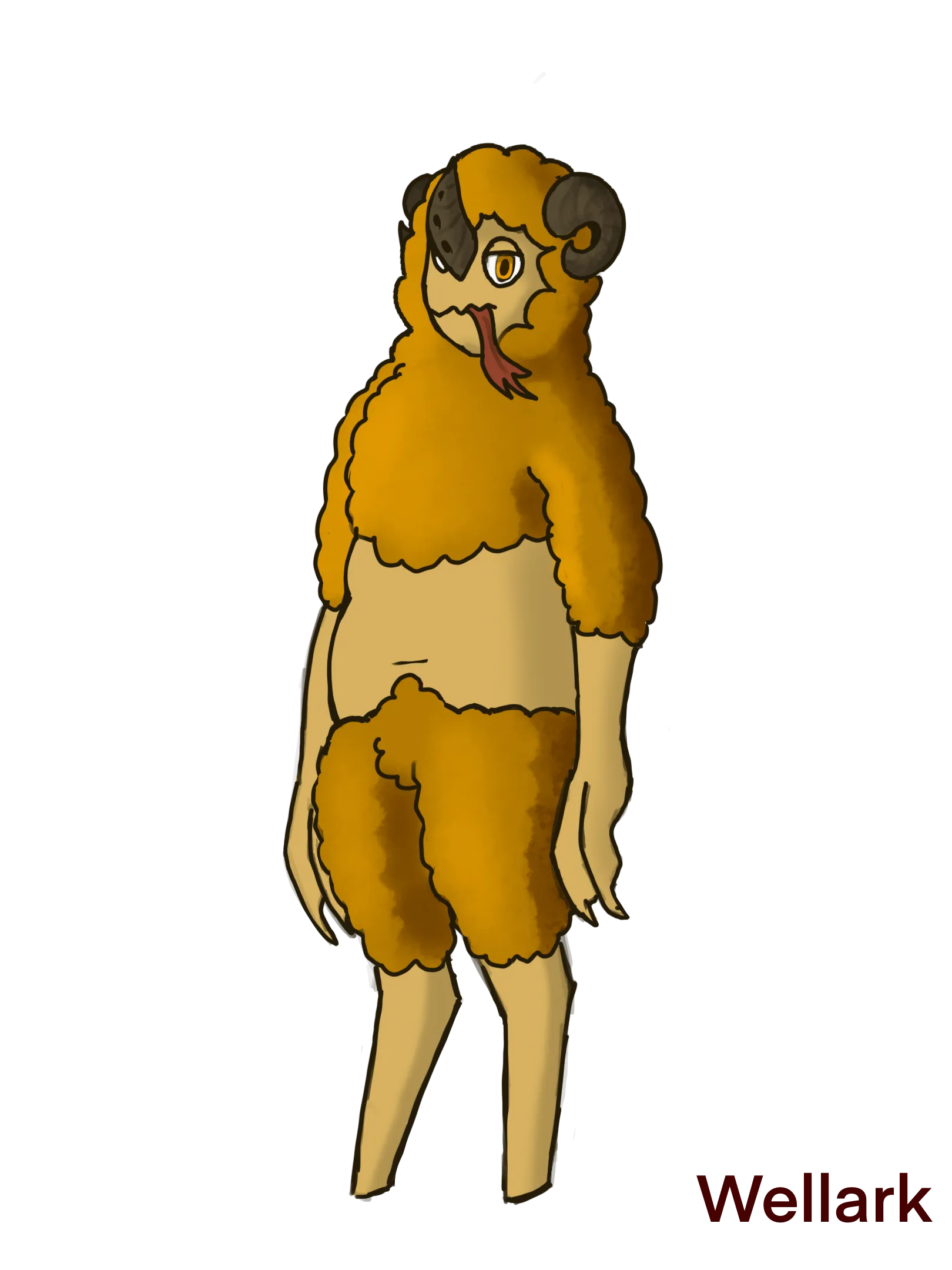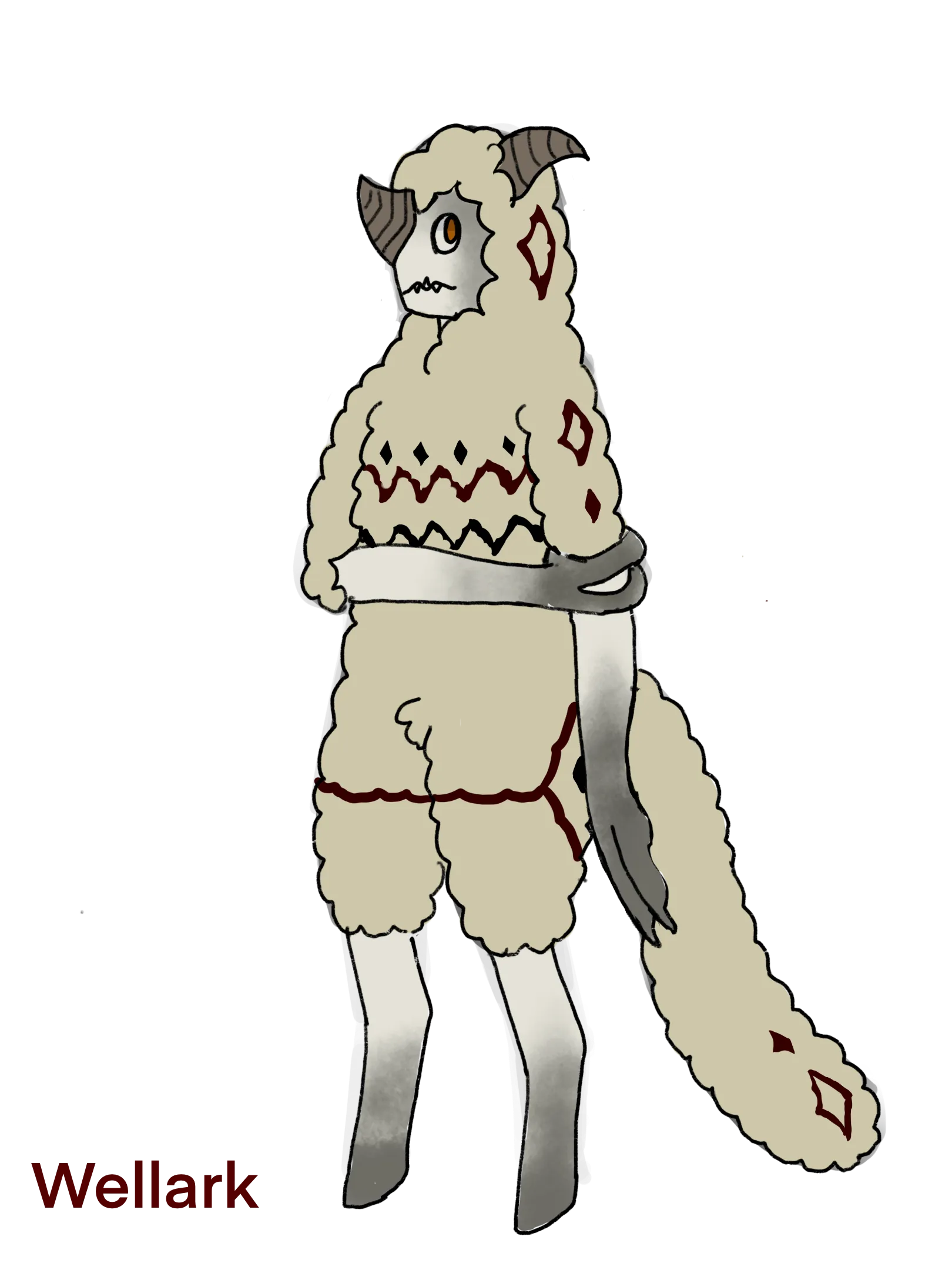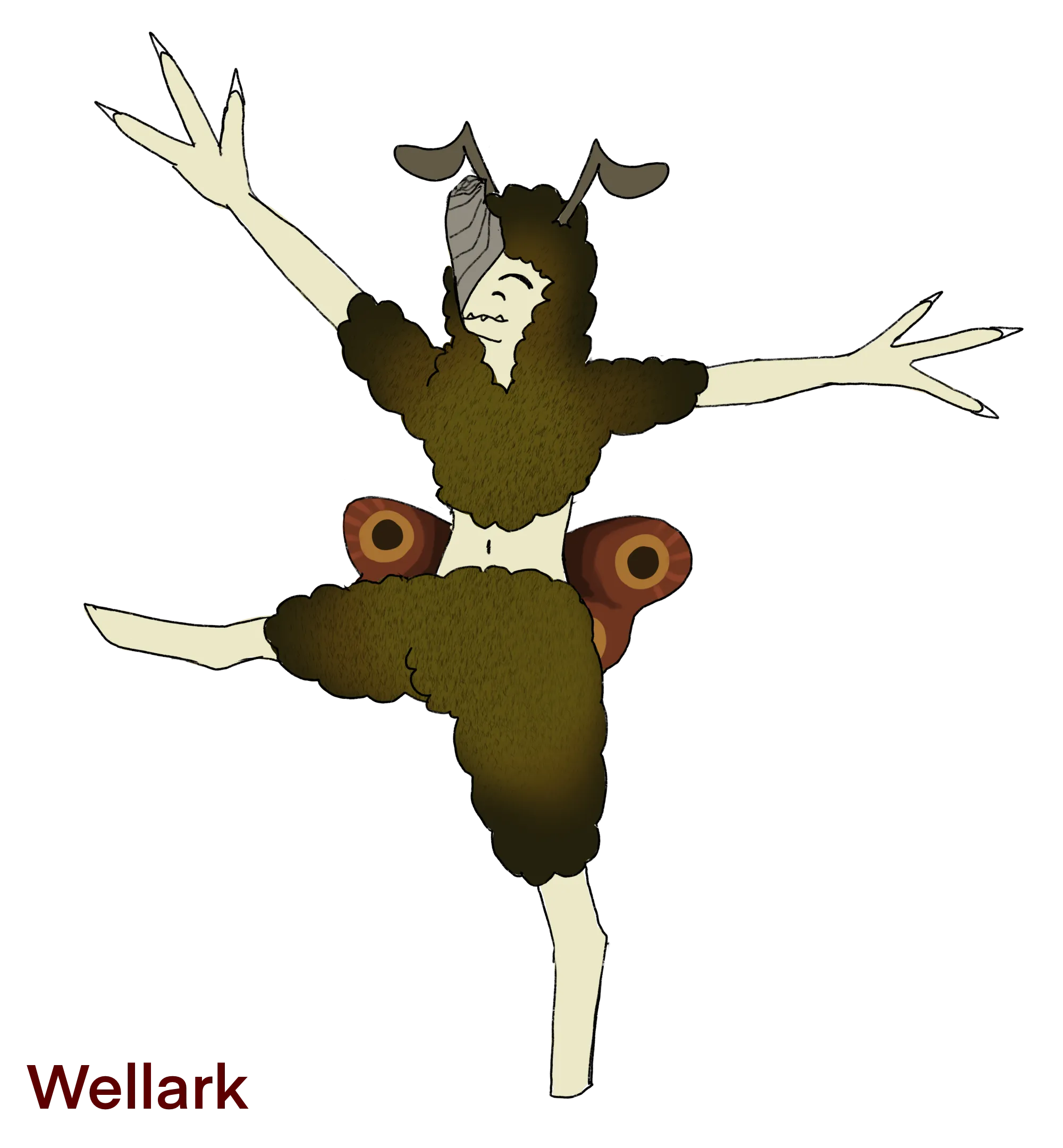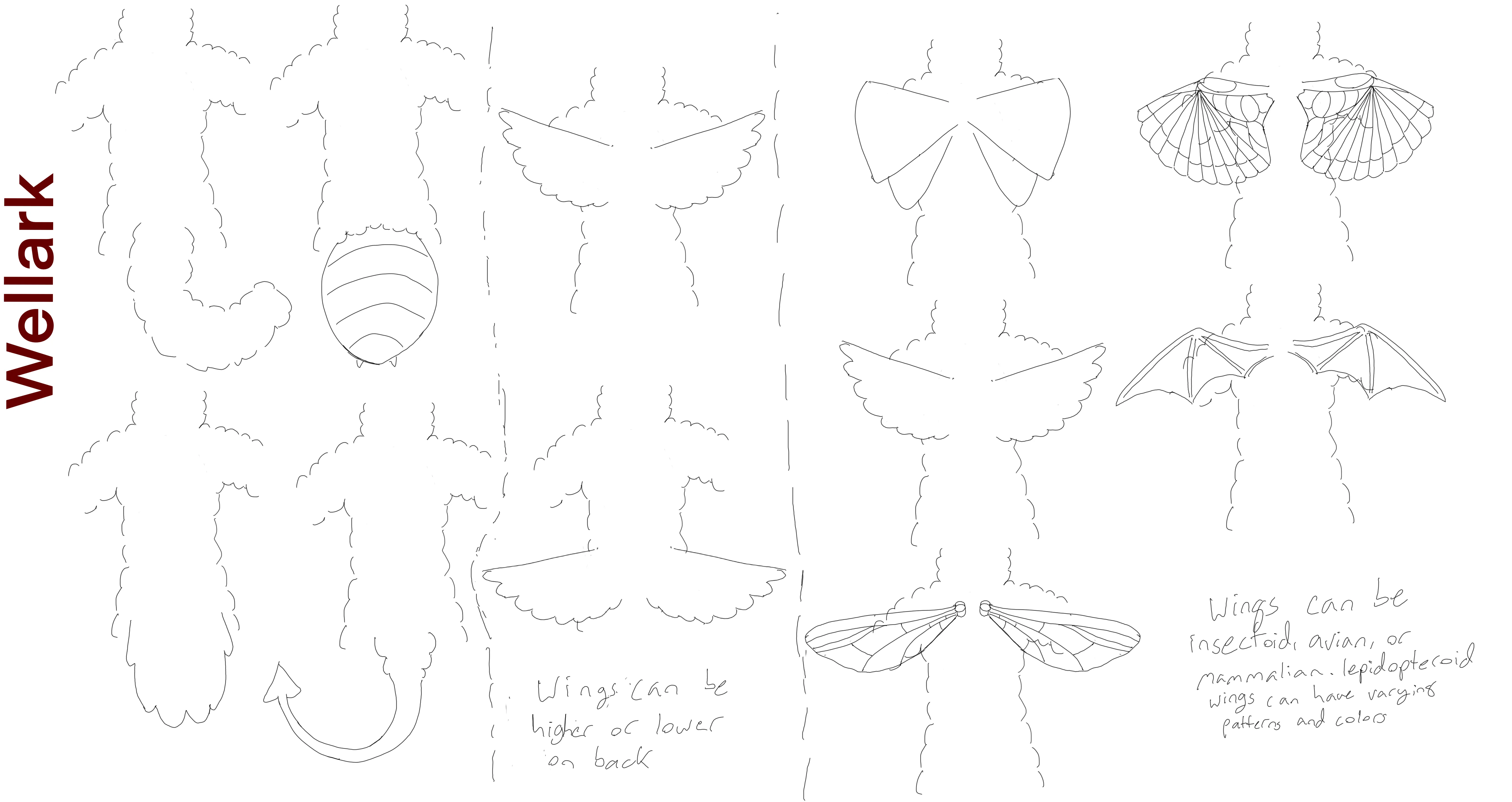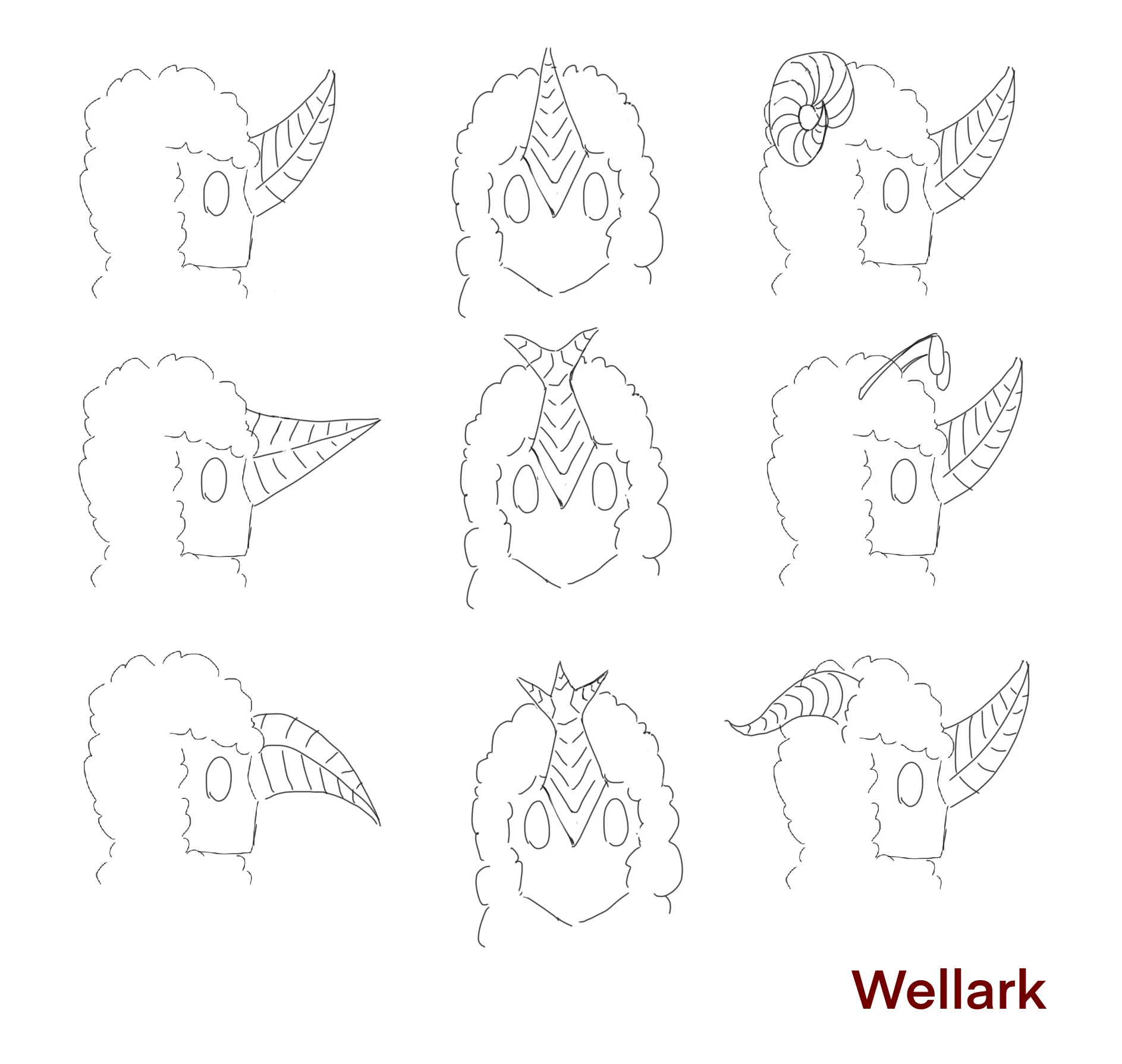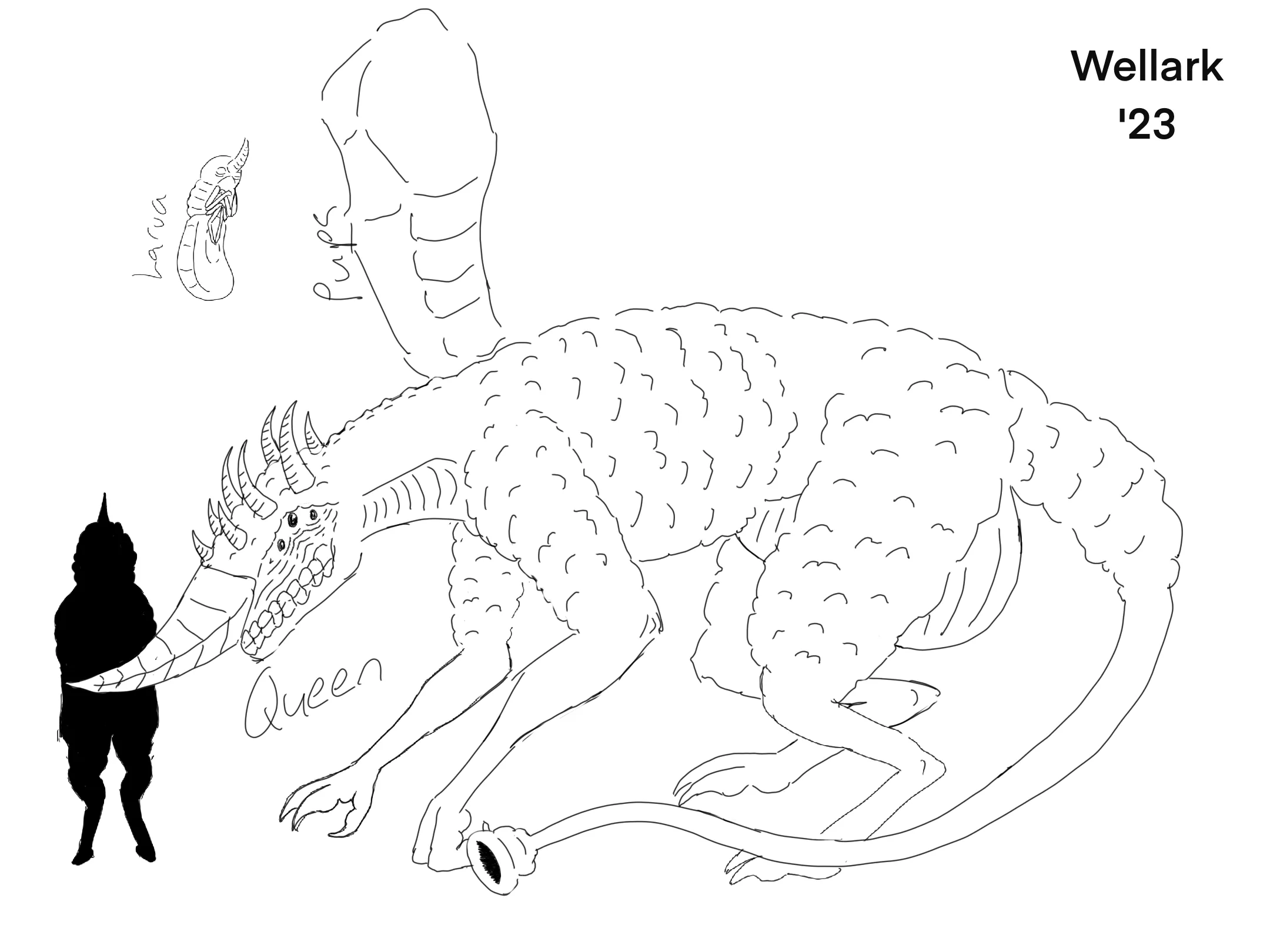Visari
The visari are a strange race of bipedal, sentient beings covered in a coat of feather-like down. The down is something feather-like but lacking a distinct shaft, making them similar to fur. These organisms stand 7-9 feet tall and bear a single horn in the center of the forehead. These horns never stop growing, meaning that the length of an individual’s horn can indicate their age. The visari have three long, clawed fingers on their hands. They walk on legs similar to cloven animals but in place of hooves are 2 fused toes with thick pads on the tips upon which they stand. The toes have a large plate-like nail akin to a human’s fingernail, fused at the center where the two toes are combined. On the sides of their heads are winglike structures from which a curtain of long fur hangs. The positions of these ears can communicate emotional state. Their tails are also a wide fan of long feathers hanging downward like the splayed tail feathers of a bird. The color of their downy coat can range from black to various shades of brown and beige. White coats are especially unusual; considered bad omens among visari communities. Individuals with white coats are killed, imprisoned, banished, or subjected to other unspeakable cruelties.
Visari start out as larvae birthed by the colony's matriarch, or Maahk, who is fertilized by a Ka-Vaar. Maahka give birth to multiple dozen larvae at a time, generally around once a year. As larvae, visari are grub-like in form and lack cognizance. During the larval stage, which lasts around 13 years, the vulnerable larvae are kept in well-guarded communal nurseries, cared for by trained adult visari with the utmost attention. Caretakers of larvae spend time feeding and watering the young, harvesting their silk, and teaching them basic concepts, such as language and culture, to prepare them for adult life. Larvae produce a strong silk-like substance which is used by the colonies in numerous ways, from more utilitarian roles such as rope, nets, and structural support to more esoteric uses like rituals, potions, and ointments. The silk has long thought to contain medicinal uses for non-visari and is a highly valued commodity among outsiders. Visari silk clothing is also highly valued due to the defense, insulation, and comfort it provides.
After approximately 10 years as a helpless, squirming larva, the visari will enter pupation. A larva undergoing pupation will form a hard shell around its soft, grubby body using silk and a secreted adhesive. Inside of this shell, the body will liquefy and reform into the body of an adult visari. During this process, pupae are moved to a special room in which they can pupate safely for the next 4 years. Each pupa is put into a ceramic vessel that is filled with a milk-like fluid produced by the Maahk. A latching lid is put on the vessel and the pupae are left undisturbed aside from regular wellness checks. At the end of pupation, the adult visari will emerge from its cocoon and shatter the vessel (unless it is too weak, in which case it will drown in the fermented milk). Each vessel sits in a larger pan or bowl, the purpose of which is to collect the fermented milk after the vessel shatters. This is later consumed by the young visari during their Rite of Imago to bless them with the Maahk’s protection. Pupation can also be induced early in a larva to guarantee it pupates far faster, also ensuring that it becomes a soldier (known as vaat-kaxyt, strong-slayers) as an adult. This process, however, is at a detriment to its mental faculties and lifespan, potentially causing multiple chronic health issues. This ritual is only done in times of great necessity, when a colony is in dire need of warriors.
After emerging from pupation, the newly adult visari is greeted by the colony with the Rite of Imago, held after the final visari of the brood emerges from pupation. At this point, the visari are confused and know very little about the world, but a young visari's mind is remarkably plastic and excels at intaking and retaining information. Physically, the visari is smaller in stature, generally standing around 5-6 feet tall and with a short horn that has only just begun to grow. If the visari is not a warrior, they are then given a specialization to pursue in order to serve the colony's interests. Some colonies let the individual choose for themself, but others dictate that a Ka-Vaar or appointed overseer must choose their role for them. Other colonies even use forms of divination to determine which path a visari will take. After a specialization is chosen, the visari becomes an apprentice and is taught by experienced tutors within their field. Throughout this time, they learn the ins and outs of their new job as well as basic fundamentals, such as math, rituals, language, and history. Some of the many specializations in which a visari can find themselves are larval caretakers, medics, construction workers, farmers, potters and craftsmen, scholars, attendants to the Maahk or Ka-Vaar, or ritualists, otherwise known as 'uhd-klixyt' or fate-artists.
The majority of visari communities reside in the Yxyltryptyc Forest Southwest of the City. Visari live in complex, large colonies that span from cavernous underground burrows to arboreal constructions. Visari colonies are comparable to ant colonies, possessing Queens (Maahka), vaat-kaxyts, and workers. vaat-kaxyts are denoted by their broad, forked horns and thick coats. Generally, the status of a visari as a worker or vaat-kaxyt is decided by fate during pupation. The colonies are governed by groups of six to twelve 'Ka-Vaar,' or Nobles. Ka-Vaar are appointed by the Maahk or selected in trial-by-combat, where a challenger duels a Ka-Vaar to the death. If the challenger wins, they must consume the body of the Ka-Vaar they killed, which will trigger a hormonal change that alters their body, mind, and soul to match that which is befitting of a Ka-Vaar. Ka-Vaar possess elongated horns and limbs, a second pair of smaller limbs below their main arms, and increased height, ranging from 12-14 feet tall. The average lifespan of the visari is 167 years, but Ka-Vaar can live up to the 300s, and Maahka can live seemingly indefinitely.
Each colony can possess one to four Maahka, depending on the size. The population of common visari can range from the hundreds to the thousands, with approximately 1/20th being vaat-kaxyts and the rest being workers. Maahks are large and highly variable in appearance, though generally more bestial in nature.
Visari colonies are largely subterranean, consisting of tunnels and large caverns burrowed deep into the ground. There are above-ground portions of many colonies as well, with buildings of wood and stone either upon the soil or high up in the towering trees of the forest. The terrestrial portions of colonies, along with the entrances into the burrows, are often protected by a large wall of wood or stone. Due to their physiology, visari are not adapted to efficiently burrow by themselves. Instead, the colonies cultivate hives of burrowing arthtropods called grk-ryt, meaning dirt-movers. To dig tunnels, grk-ryt are released on an area that the visari want excavated. The visari will use strategically placed heat sources and waste matter produced by the Maahk, the preferred food of the animals, to direct them to dig the tunnels and caverns to the visari's desired specifications. During this process, the loose dirt will be moved to the surface by visari workers. As the grk-ryt dig the tunnels and rooms, they secrete a sticky substance, called grk honey, on the walls of the burrows. This honey significantly increases the integrity of the walls. Due to variations in the diets of grk-ryt between different colonies of visari, it is noted that the ambient aroma of each colony's burrow is markedly different. Colonies that feed their grk-ryt large amounts of decomposing meat are said to have burrows that give off a heavy, metallic smell. Visari also have many other applications for grk honey, such as a flavor additive for food and beverages. Grk honey is also used in incense and sold as glue. grk-ryt are kept in specialized rooms with their own smaller hives built into the walls, ceiling, and floor. After the appearance of the Pale Sun, the global temperature dropped dramatically. This resulted in mass die-offs of grk-ryt. As a result, physical expansion of visari colonies decreased severely, leading to overcrowding in the colonies. This created uncomfortable, unhygienic conditions and increased spread of disease amongst visari. Visari then began to keep heat sources near the grk-ryt hives, allowing the populations to slowly rebound. Some colonies suffered far more than others, a small number being completely eradicated.
The diet of a visari generally consists of a fungus known as Galamina, cultivated in subterranean areas, along with some meat from small mammals and invertebrates. The main livestock of the visari are rats and insects. Some colonies are also known to actively forage, hunt, and fish. The fungus grown by visari can be used to produce a psychoactive substance used by humans. This drug, when overused, can transform the user into an orck. The drug of choice for visari, however, is Buul, a drink produced by fermenting yonderwort flowers with various other ingredients for flavor. The beverage is said to produce a euphoric, stimulating high that increases focus, productivity, and pain tolerance. Buul can have potentially severe adverse effects if overused, such as inducing nausea, irritability, weakness, heart palpitations, high blood pressure, and confusion.
Communication is done through speech in combination with chirps, whistles, touch, and pheromones. Visari in the Outside primarily speak the same tongue. A simple language with short, choppy words. The colonies each have vastly different dialects and accents from one another, meaning one can often identify an individual's mother colony by how they speak. As visari speak, they incorporate chirps and whistles, used in certain words or frequently as shorthands for certain terms, exclamations, or other miscellaneous vocalizations. As a result, it is challenging for most non-visari to speak the language fluidly. Visari also use gestures while speaking, just as non-visari do. Most of their gestures closely resemble those commonly found in non-visari communication, though some are strange and unique to visari culture. Visari colonies that interact with human societies, such as the Old City, typically speak the common language as well as the visari's for the sake of diplomacy and commerce, though more isolated colonies tend to only speak the visari language.
Visari have a number of different pheromones they can produce, often given off unconsciously. They can also be intentionally secreted to non-verbally communicate signals to nearby visari. Many pheromones are social in nature, and are used to communicate feelings and emotions. Other pheromones might be used to mark possessions and territory, communicate a visari's health, or indicate the presence of danger in an area. Certain pheromones are specific to their respective colonies, with only visari of those colonies being able to produce and recognize them. There are, however, a number of universal pheromones that can be produced, detected and recognized by all visari regardless of colony. Each visari has a distinct pheromonal profile that denotes their home colony. Individually, every visari has a subtly distinct "scent" that they can be recognized by, generally only detectable by other visari or, potentially, humans close to that individual. A large number of pheromones are undetectable to humans, though some are mildly aromatic. While some may be commonly considered unpleasant to smell, certain other visari pheromones are highly valued in the aromatics industry. Although it is taboo, there are black market perfumes, oils, lotions and incenses using pheromones extracted from visari. The primary procedure to extract visari pheromones involves surgically removing the pheromone glands, customarily after using some form of mind-alteration to induce a mental state necessary for the visari to begin producing the pheromone desired. The glands are then extracted and the organ is kept alive and continually producing the pheromone for a time by using special equipment. Such extractions are usually done against the will of the visari and performed with little regard to their safety or health. Nevertheless, there are visari that opt to sell their glands in exchange for monetary compensation.
Visari culture is highly dogmatic and superstitious, putting an emphasis on hierarchy and connection to nature. Visari colonies are very secretive, rarely allowing other species to live among them. It is considered a great honor to be accepted into a visari colony. War is common among the colonies as they fight for land, resources, and ideals. Different colonies are rarely on good terms with each other but are willing to trade with other species on occasion. Visari are also commonly scavengers of the Yonderlands, using the resources collected to produce various goods used in daily life or trading with humans.
ue to their magical nature, the Visari played an instrumental role in both the Ritual of the Pale Sun and the ensuing counter-ritual that blanketed the world in cloud cover. This has brought great shame to the visari and they have become highly reluctant to teach humans their rituals. Pelmagic is also widely loathed by the species, seen as a perversion of Uhd and nothing more than a punishment brought upon the world for their hubris.
Click the images to see them at full size.
